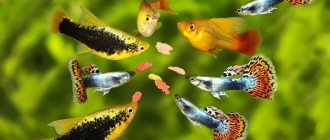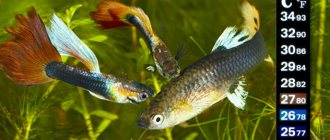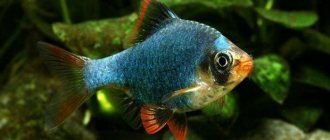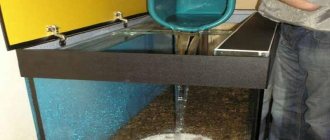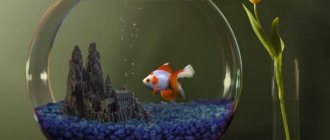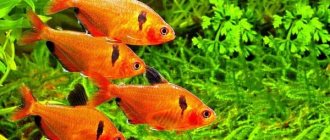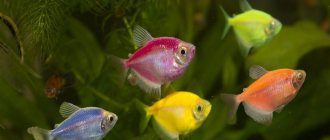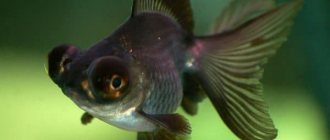Description and habitat
Other names for Acantophthalmus are Prickly Eye, Pangio, Acanthus, Prickly Eye, Leopard Loach, Cinnamon Loach.
This is a freshwater fish of the loach family, having a serpentine-shaped body, up to 12-15 cm long with bright transverse stripes.
The fish's eyes are covered with a translucent protective film, and under them there are spikes, which gave it the name Spiny Eye.
The flat body, covered with scales, is slightly flattened at the bottom, and has small fins. The antennae on the sides of the mouth help the fish navigate in space and search for food.
These peaceful, omnivorous inhabitants of water bodies prefer to be nocturnal.
Acantophthalmus is native to India and other regions of Southeast Asia (Sumatra, Java, Borneo, Singapore, Thailand, Malaysia), streams, sandy areas of rivers and small reservoirs with a muddy bottom and a calm current. They prefer shaded areas under trees; this especially attracts fish because the ground in this case is lined with fallen leaves.
It lives in small groups (although it is not a schooling fish) or alone. At home, with good care, it can live up to 10 years.
Active breeding in aquariums of one of the common species of Acantophthalmus - Kühl - began in the 80s of the last century.
Photo gallery of Acantophthalmus:
Description of the aquarium fish
Latin name: Acanthophthalmus, Pangio.
Russian-language name: snake, worm fish, acanthophthalmus, spiny-eyed loach.
Order : carp-like.
Family: loaches.
Suitable water temperature: 22-30 °C.
Acidity Ph : 6.5 – 7.2 pH.
Hardness dH: 5-6.
The body of the fish is worm-shaped, slightly flattened on the sides and in the area of the tail, there is no lateral line. There are small scales on the body. The head of acanthophthalmus is small, the eyes are protected by a transparent film. The mouth is located below. There are 3 pairs of whiskers around the mouth. The fins are small in size. The dorsal fin is located on the back of the body. In an aquarium, the female grows up to 12 cm, and the male is slightly smaller, up to 10 cm. The body of the worm is decorated with transverse stripes of black and brown color. The abdomen of adult females is more rounded in contrast to the abdomen of males.
Two types of acanthophthalmus are popular among aquarists: Acanthophthalmus Kühl and Acanthophthalmus Myers.
Interesting features
Acantophthalfus is notable not only for its serpentine body, but also for a number of other interesting features:
- The fish has several types of respiration - through the skin and using the air supply in the stomach. She gains it by periodically rising to the surface of the reservoir.
- Acanthus are true barometers of atmospheric pressure. When it fluctuates, they gather in flocks and actively move in different layers of the reservoir, although in a calm state they prefer a bottom lifestyle. This is explained by the peculiarity of the air bubble located in the body of the fish in a special bony shell.
- The spikes under the eyes look very unusual, but have a useful function. They help the fish make its way through thickets of aquatic plants. Acanthus, turning its head, clings to the grass with its shoot and pulls up its body. In addition, this is a serious and very sharp weapon. If a large fish swallows an Acanthus, the latter is capable of cutting through the stomach of the predator with its spines, killing the hunter and getting out to freedom.
- Acanthus are great at hiding. During the day they are difficult to find in the aquarium - they expertly bury themselves in the bottom filler or hide among thickets of algae and decorations, curling up into balls.
Maintenance and care, arrangement of the aquarium
For a group of 4–5 individuals, the optimal aquarium size starts from 60 liters. The design should include places for shelter (snags, thickets of plants) where the fish will hide during the day. Another required attribute is the substrate. It is necessary to provide soft, fine-grained soil (sandy) so that the fish can partially burrow into it.
It is worth remembering that in search of reliable shelters, these fish may accidentally end up in unprotected holes in the filtration system tubes!
The content is quite simple if the values of hydrochemical indicators correspond to the norm, and the degree of pollution with organic waste is at a low level.
Aquarium maintenance is standard. At a minimum, it is necessary to replace part of the water weekly with fresh water, which can be conveniently combined with soil cleaning, and to carry out equipment maintenance.
Mr. Tail recommends: Acantophthalmus species
There are many species in this group of bindweed fish. But only a few of them have become widespread in the aquarium hobby.
Acantophthalmus Kühl
Pangio (Acanthophtalmus) kuhli sumatranus is the most common Acanthus species in home aquariums. The species received its name in honor of the German zoologist Heinrich Kühl, although it was first described by the Frenchman Achille Valenciennes.
The long body (8-13 cm) is flattened on the sides and especially in the tail. The plumage is almost invisible, and the dorsal fin is strongly displaced towards the end of the body. The mouth is located very low and is equipped with pharyngeal teeth, around it there are four pairs of antennae.
The spines under the film-covered eyes are double. The main color is from pinkish to deep orange. The stripes are a little brighter and there can be from 6 to 20 of them.
These peace-loving fish should coexist with calm aquarium inhabitants - discus, swordtails, platies, lalius, macropods. At the same time, they can live more than 10 years.
Acantophthalmus Myers
Pangio myersi, Acanthophthalmus myersi is the largest aquarium species of Acanthus (more than 12 cm). The body is not only longer, but also thicker and completely (except for the head) covered with small scales.
The spines under the eyes are forked, and there are three pairs of antennae near the mouth. The main background of the body is dark yellow or red. The stripes are almost brown and there are from 10 to 14 of them. Lifespan is about 5 years.
Semi-cingulate Acantophthalmus
Pangio (Acanthophthalmus) semicinctus is not very different from its relatives. Only with a shorter body length (up to 8-9 cm) and the owner of stripes that do not close on the stomach, which gave the name to the variety. But the two lines on the head are always closed, and on the body there are from 12 to 16.
This Acanthus has three pairs of antennae and a lifespan of up to 5 years.
Several other species are also found in home ponds, for example, Pangio (Acanthophtalmus) scholfordi, Pangio (Acanthophtalmus) cuneovirgatus, Pangio (Acanthophtalmus) robiginosus.
Varieties
Acantophthalmus is a group that includes several species. They differ from each other only in external characteristics.
Features of acanthophthalmus Kühl, Myers and semi-girdled - table
| Acantophthalmus Kühl | Acantophthalmus Myers | Acantophthalmus semi-girdled | |
| Body | In appearance it resembles an eel. The body is snake-like, noticeably compressed at the sides. The fins are small. The mouth is lower, near it there are 4 pairs of antennae. The eyes are small, covered with a film, and one spike is placed under them. | Myers has 3 pairs of antennae. They, like Külya, have spikes under their eyes and a protective film. | The body is serpentine, slightly thickened near the tail. The mouth is lower, there are three pairs of antennae. |
| Colors | The color of the fish can be pink or orange-yellow with dark stripes. Their number on the body reaches 6–20 pieces. | The color of the fish varies from red to yellow. There are from 10 to 14 dark brown wide stripes on the body. | The peculiarity of these fish is their color. The stripes, which are also dark brown in color, do not meet on the abdomen. Their number is 12–16 pieces. Only three stripes are connected near the head and another one near the tail. |
| Dimensions | Kühl's acanthophthalmus grows to 9–12 cm in length. | Myersa is also larger in size. Its length is 12 cm, but this fish is noticeably thicker than other varieties. | The size of the Half-Belted is relatively small - 8 cm. |
| Lifespan | Representatives of this species live up to 10 years. | The fish lives up to 5 years. | Life expectancy does not exceed 5 years. |
Species diversity in the photo
Acantophthalmus Myers has a lighter color
Acantophthalmus semi-girdled is small in size.
Acantophthalmus Kühl - the most common type
Aquarium Basics
Acantophthalmus is an unpretentious fish and it is not difficult to keep it in an aquarium.
Acanthus lead a benthic lifestyle and the optimal parameters for their aquarium maintenance are as follows:
- The desired tank capacity for 5-8 individuals is about 100-120 liters.
- The best soil is coarse river sand. Pebbles are undesirable, as acanthus likes to burrow into the filler and can be injured.
- An artificial reservoir should have decorations in the form of caves, grottoes, driftwood, piles of stones, halves of coconut shells, since Acanthus prefer to hide in the shade during the day.
- Water filters and aeration devices are necessary, but their intake openings must be covered with a protective mesh, because the narrow and long body of Acanthus can easily get into the equipment.
- Lighting should be dimmed; Acantophthalmus loves partial shade.
- The water in the aquarium must meet the following parameters: temperature +21...+27 °C, hardness - 5-10 dH, acidity within 5-5.8 pH.
Acanthus periodically rise to the surface of the water to fill the stomach with air, but if this happens too often, it means that something is wrong in the biological environment of the reservoir. You should siphon the soil and replace some of the water.
It must be remembered that Acanthus can easily “escape” from the tank, so it must have a lid (with a sufficient layer of air) or a protective mesh with a fine mesh.
The preferred vegetation for Acanthophalmus are Java mosses, Thai ferns, and tiger water lilies.
Who can you keep in an aquarium?
Acantophthalmus are peaceful in nature. They are best kept with other small non-aggressive fish - Neon , Mollies, Corydoras, Danios, Rasboras, Guppies, Tetras, Swordtails, Norman's Blueeyes, Small Catfish.
Loaches spend most of their time swimming along the bottom, collecting garbage and eating leftover food that ends up on the sand. Therefore, their ideal aquarium companions are those fish that occupy the upper areas of the aquarium.
Aquarium shrimp Cardinal and Cherry shrimp are also good aquarium mates.
Gourami can make a worthy company, since most of the time they swim either in the middle or in the upper part of the aquarium.
Fish that should not be placed in an aquarium with Acantophthalmus:
- cichlids, arowana and other large fish;
- tiger Barbus, Girinocheilus and other fish that have aggressive behavior and can cause injury to Acantophthalmus;
- Blue Gourami, Cockerel and Red-tailed Sharks drive other fish out of their territory. In a limited capacity, particularly in an aquarium, this increases the risk of Acantophthalmus jumping out of the aquarium.
It is not advisable to place loaches together with predatory aquarium snails.
Feeding
Despite the fact that Acanthus are not a predatory species, they are omnivorous - they absorb any type of live, frozen, dry and plant food that sinks to the bottom.
They love bloodworms, tubifex, daphnia, artemia nauplii, echytraea, cyclops, small snails, spirulina tablets. Occasionally it is necessary to provide food with natural carotenoids to enhance the color of the fish. It is advisable to pre-disinfect live food in an Ichthyphora solution so as not to introduce infection into the aquarium. Frozen ones are not dangerous in this regard, but some proteins, fats and carbohydrates are lost.
In addition, Acantophthalmus are good tank cleaners, as they happily eat leftover food from other fish and are able to dig them out of the ground.
Feed 3-4 hours before dark at night. Food should be eaten within 4-5 minutes, portion sizes should be limited.
What to feed acanthophthalmus
The diet of acanthophthalmus also takes into account the peculiarities of their lifestyle. These fish are fed closer to night, at least 3 hours before turning off the lights. It is important that food particles fall to the bottom.
Like other aquarium inhabitants, there is no need to overfeed acanthophthalmus. A portion of the poured food should be eaten within 5 minutes.
The menu of these fish must include live food: small snails, tubifex, bloodworms, cyclops and carriages. Dry food is administered in the form of special tablets for bottom feeding, which contain spirulina and plant fiber. We recommend TetraRubin or TetraPro Color Crips, which contain natural carotenoids (these substances make the color of the fish brighter).
Live fish food is a source of proteins and vitamins that are easily digestible. Its disadvantage is that edible crustaceans and snails can be a source of infections and toxic substances. To prevent infection, live food is first disinfected (soaked in Ichthyphorus solution for about half an hour).
Frozen foods are also used to feed acanthophthalmus - they come in the form of cubes and are completely ready for consumption. There are no dangerous infections in such feeds, but during processing they lose some beneficial properties.
Compatibility
Acanthus are so peaceful that they will never touch any of the underwater inhabitants, even shrimp. But it is better to choose their neighbors among calm fish, so that the Pangios themselves do not suffer. Suitable species include thorns, neons, zebrafish, characin species, tetras, shrimp, gourami, guppies, apistogramma, Asian loaches, and angelfish.
It is not recommended to combine with cichlids, silver crucian carp, labeo, barbs, acara, astronotus, carp, loachfish, corydoras and speckled catfish. In the latter case, quarrels over bottom territories are inevitable.
Breeding
Reproduction of Acantophthalmus is seasonal, but breeding them at home is extremely difficult, usually requires hormonal injections and is recommended only for experienced aquarists.
Sex differences are extremely weak. Females are usually slightly larger than males and their abdomen is translucent, revealing greenish granular eggs.
For the breeding process, you will need a special spawning tank with a large bottom area (from 1 thousand sq.cm.). The water level should be low (up to 20-25 cm) to make it easier for Acanthus to rise to the surface for breathing. A special separator mesh is laid on the ground, and numerous aquatic plants take root on it.
The lighting should be dim, slightly increased acidity (6-7 pH), hardness 6–15 dGh, temperature +25…+28 °C.
To stimulate reproduction (simulating the monsoon season), water should be changed daily (10-20% of the total volume). For breeding, adult fish older than 12 months are selected; it is better to choose females with a large, thick belly.
Hormonal injections are given as follows:
- Acanthus are planted in a separate container. A three-liter jar will do.
- Add a couple of drops of Novocaine or Tricaine to the water.
- After the fish fall asleep, they are carefully removed one by one with a soft net, placed on a damp cotton swab and an injection of human chorionic gonadotropin is injected under the back fin at the rate of 50-140 m.u. depending on the size of the individual. At the same time, the head is slightly pressed with a piece of wet cotton wool. You can also insert a needle into the abdominal cavity near the anal fin (towards the head).
- Half-asleep fish are lowered into the spawning tank. This state will remain for up to 4-6 hours.
After some time, males begin to show interest in females. This is manifested by a kind of courtship - hugging with pectoral fins, pressing head to head.
If the mating games were successful, then the females lay up to 600-700 eggs. This usually happens when the couple rises to the surface, greenish eggs are released from the female body in sharply small portions. The masonry sinks to the bottom under the net, and thus becomes inaccessible to fish (they can eat the eggs).
The parents are removed from the spawning tank, the water is treated with mycopur or another fungicide to disinfect it from bacteria and saprolengia, and the fry are waited for to appear.
The eggs begin to hatch after about a day or two; by the end of the first day, the larvae grow tails, and by the fourth or fifth day they are already swimming and feeding on their own. The first feeding should consist of live dust, grindal, and rotifers.
Lighting should remain dim - juveniles cannot tolerate bright light and often hide in shelters. By two to three weeks, the fry grow to two to three cm and spots appear on their body in place of future stripes. Now they can be switched to larger live food.
Reproduction
Sex differences in acanthophthalmus are weakly expressed. If there is only one representative living in an aquarium, it will be difficult to tell for sure whether it is male or female. How to determine the sex if there are several fish:
- females are larger than males;
- the male has slightly larger pectoral and ventral fins;
- The female's belly is slightly larger, the skin in this place is slightly translucent, which is why the eggs are visible.
Breeding acanthophthalmus at home is a complex process that requires skill. Requirements for the spawner:
- volume 100 l;
- soft, slightly acidic water;
- temperature 26-28°C;
- separate mesh on the bottom.
To stimulate spawning, each fish is given an injection of human chorionic gonadotropin. Rules for administering hormonal injections: the fish is placed in a small volume, a little novocaine is added to the water, which immobilizes the fish for a short time. All this must be done extremely carefully and competently, otherwise the fish can be destroyed.
Females and males over a year old are selected for breeding. After a hormonal injection, the fish are placed in a spawning tank, and after 7-8 hours pairs begin to form. The mating dance of fish: the male “hugs” the female with his fins, pressing against her. The female lays eggs, which fall to the bottom through the separator net. This happens several times. After spawning, fish from the spawning tank are placed in a common aquarium.
After 4 days, the eggs become larvae and can be fed with live dust. The aquarium with the fry should be shaded. When the fry reach a size of 2 cm (25-30 days old), they are able to feed on adult food.
